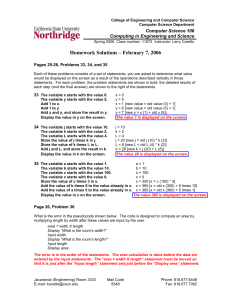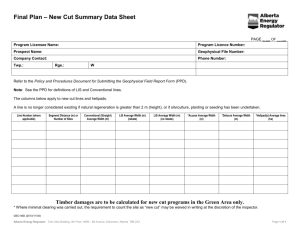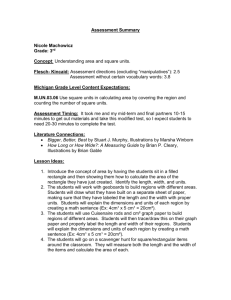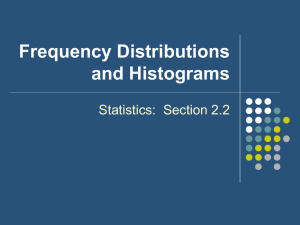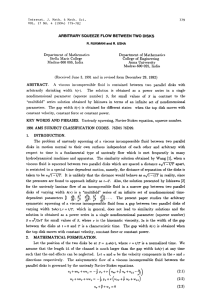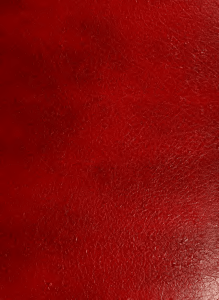Chapter 2 Introduction to the C Language
advertisement
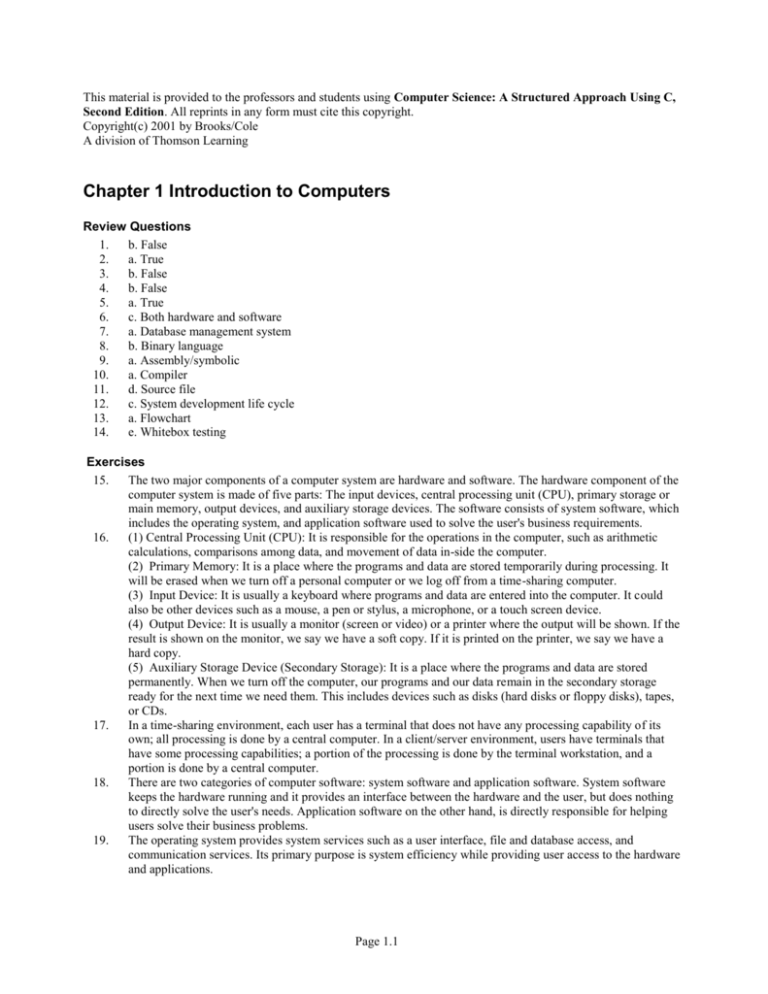
This material is provided to the professors and students using Computer Science: A Structured Approach Using C, Second Edition. All reprints in any form must cite this copyright. Copyright(c) 2001 by Brooks/Cole A division of Thomson Learning Chapter 1 Introduction to Computers Review Questions 1. b. False 2. a. True 3. b. False 4. b. False 5. a. True 6. c. Both hardware and software 7. a. Database management system 8. b. Binary language 9. a. Assembly/symbolic 10. a. Compiler 11. d. Source file 12. c. System development life cycle 13. a. Flowchart 14. e. Whitebox testing Exercises 15. The two major components of a computer system are hardware and software. The hardware component of the computer system is made of five parts: The input devices, central processing unit (CPU), primary storage or main memory, output devices, and auxiliary storage devices. The software consists of system software, which includes the operating system, and application software used to solve the user's business requirements. 16. (1) Central Processing Unit (CPU): It is responsible for the operations in the computer, such as arithmetic calculations, comparisons among data, and movement of data in-side the computer. (2) Primary Memory: It is a place where the programs and data are stored temporarily during processing. It will be erased when we turn off a personal computer or we log off from a time-sharing computer. (3) Input Device: It is usually a keyboard where programs and data are entered into the computer. It could also be other devices such as a mouse, a pen or stylus, a microphone, or a touch screen device. (4) Output Device: It is usually a monitor (screen or video) or a printer where the output will be shown. If the result is shown on the monitor, we say we have a soft copy. If it is printed on the printer, we say we have a hard copy. (5) Auxiliary Storage Device (Secondary Storage): It is a place where the programs and data are stored permanently. When we turn off the computer, our programs and our data remain in the secondary storage ready for the next time we need them. This includes devices such as disks (hard disks or floppy disks), tapes, or CDs. 17. In a time-sharing environment, each user has a terminal that does not have any processing capability of its own; all processing is done by a central computer. In a client/server environment, users have terminals that have some processing capabilities; a portion of the processing is done by the terminal workstation, and a portion is done by a central computer. 18. There are two categories of computer software: system software and application software. System software keeps the hardware running and it provides an interface between the hardware and the user, but does nothing to directly solve the user's needs. Application software on the other hand, is directly responsible for helping users solve their business problems. 19. The operating system provides system services such as a user interface, file and database access, and communication services. Its primary purpose is system efficiency while providing user access to the hardware and applications. Page 1.1 20. 21. 22. 23. 24. 25. 26. 27. 28. 29. 30. 31. System software used to develop our programs includes the text editor to create the program, a compiler to convert it to machine language, and debugging tools. General-purpose software can be used for more than one purpose. Examples include word processors, spreadsheets, and database management systems. Application-specific software solves a specific business problem and cannot be used for other purposes. Examples include personal finance systems and general ledger accounting systems. There are four levels of computer languages from the most primitive one to the today's highly productive ones: a. Machine languages b. Symbolic languages c. High-level languages d. Natural languages Symbolic languages, often called assembly languages, provide mnemonics for machine instructions, data identifiers, and other objects such as functions. They allow the programmer to write program instructions that basically mirror the machine instructions. High-level languages, on the other hand, are machine independent and allow the user to concentrate on the problem being solved rather than the hardware on which it is being solved. Generally, each high-level language statement generates many machine language statements. A source program is written in a text editor so that it can read or edited. An object module has been compiled into machine language from a source program, so we cannot read it. The system development life cycle contains six steps: a. System requirements: Define the requirements for the system. b. Analysis: Evaluate alternative solutions to requirements. c. Design: Describe the specific implementation for the problem. d. Code: Prepare and unit test programs based on the design. e. System test: Verify that the programs integrate and work as a system to satisfy the user requirements. f. Maintenance: Keep the system working in production. A programmer should receive: a. The program requirements statement b. The design of any program interfaces c. An overview of the complete project The four steps to develop a program are: a. Understand the problem. b. Develop a solution. c. Write the program. d. Test the program. There are three tools used to develop a program solution: a. Structure chart: It shows the functional flow through our program. In other words, it shows how we are going to break our program into logical steps; each step will be a separate module and the whole structure chart shows the interaction between all of the modules. b. Flowchart: It uses standard graphical symbols to represent the logical flow of data through a function. c. Pseudocode: It is part English, part program logic. Its purpose is to describe, in a precise algorithmic detail, what the program being designed is supposed to do. "Resist the temptation to code" means that the programmer must fully understand the problem and design a solution before beginning the process of writing code. It is human nature to want to get to the coding step as soon as possible, but this often leads to poorly implemented and inefficient programs. Blackbox testing consists primarily of testing based on user requirements and assumes no knowledge of the inner workings of the program while whitebox testing, executed by the programmer, tests the program with full knowledge of the program’s operation. Software engineering is the use of sound engineering methods and principles to develop software that works. Page 1.2 Problems 32. Algorithm calcLivingAreas 1. Prompt user for famRoom width 2. Read familyRoom width 3. Prompt user for famRoom length 4. Read famRoom length 5. famRoom area = famRoom width * famRoom length 6. Prompt user for dineLive width 7. Read dineLive width 8. Prompt user for dineLive length 9. Read dineLive length 10. dineLive area = dineLive width * dineLive length 11. Living areas = famRoom area + dineLive area end Algorithm calcLivingAreas 33. No standard answer. 34. No standard answer. Page 1.3


